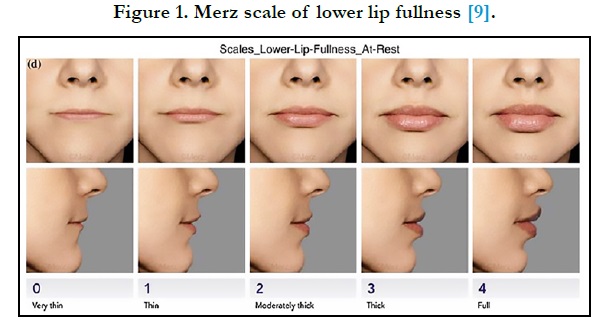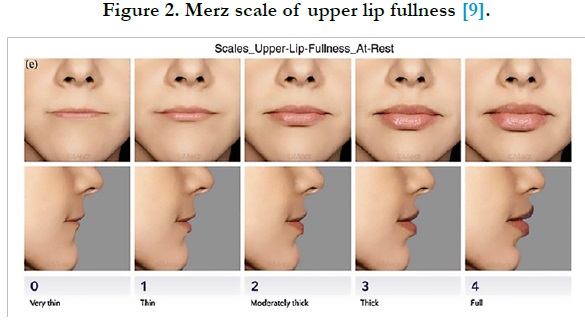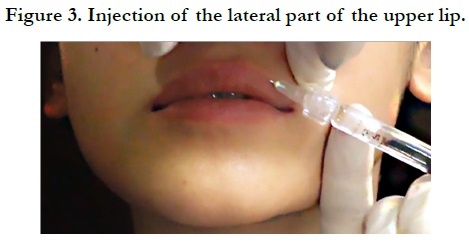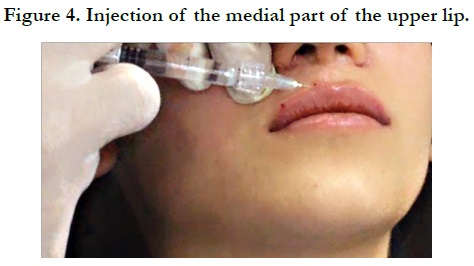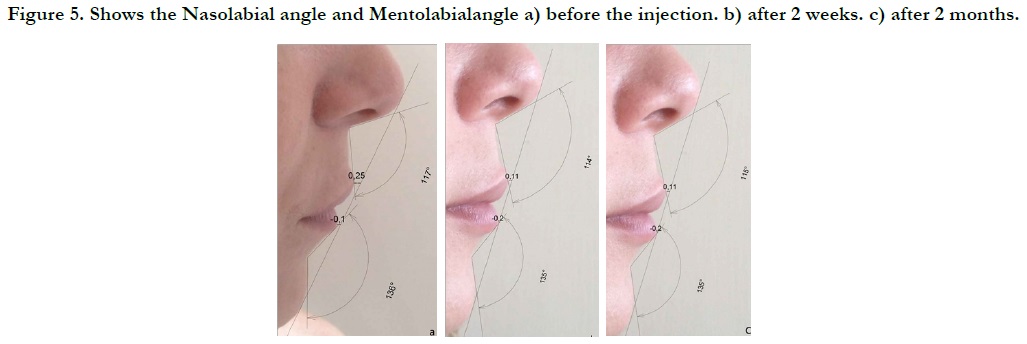Changes in Nasolabial angle and Mentolabialangle after lips augmentation with hyaluronic acid: Clinical Study
Mohamad Droubi1, Yasser AL-Moudallal2, Manal Mouhamad3, Zuhair Al-Nerabieah4*
1 Department of Oral and Maxillofacial Surgery, Faculty of Dentistry, Damascus University, Syria.
2 Department of Oral and Maxillofacial Surgery, Faculty of Dentistry, Damascus University, Syria.
3 Professor, Department of dermatology, Faculty of medicine, Damascus University, Damascus, Syria.
4 Pediatric dentistry department, Dental Collage, Damascus University, Al-Mazzeh St. Damascus, Syria.
*Corresponding Author
Zuhair Al-Nerabieah,
Pediatric dentistry department, Dental Collage, Damascus University, Al-Mazzeh St. Damascus, PO Box 30621, Syria.
Tel: +963969960118
E-mail: zuhairmajid@gmail.com
Received: October 31, 2020; Accepted: November 06, 2020; Published: November 12, 2020
Citation:Mohamad Droubi, Yasser AL-Moudallal, Manal Mouhamad, Zuhair Al-Nerabieah. Changes in Nasolabial angle and Mentolabialangle after lips augmentation with hyaluronic acid: Clinical Study. Int J Dentistry Oral Sci. 2020;7(11):1012-1016. doi: dx.doi.org/10.19070/2377-8075-20000201
Copyright: Zuhair Al-Nerabieah©2020. This is an open-access article distributed under the terms of the Creative Commons Attribution License, which permits unrestricted use, distribution and reproduction in any medium, provided the original author and source are credited.
Abstract
Background: The nose-lip-chin relationships are very important in determination of facial aesthetics. This study aim was to
evaluate the effect of injection of fillers in lips using hyaluronic acid on nasolabial angle and mentolabial angle.
Methods: A total of 25 females aged between 19 and 40 years were enrolled in this study. Hyaluronic acid was injected to improve
their lips. The nasolabial angle and mentolabial angle were evaluated by comparing the photographs taken before the injection, two
weeks after and two months after. AutoCAD 2017 engineering drawing program was used for image processing and dimensional
calculation. The T-Student test for a paired sample was used to compare the measurements of the studied variables between the
three time periods of the study.
Results: There was a statistically significant difference (p value <0.05) when using hyaluronic acid in lips augmentation on the
nasolabial angle and mentolabial angle.
Conclusions: The injection of hyaluronic acid for lips augmentation decreases both nasolabial angle and mentolabial angle. The
amount of the decrease did not affect the aesthetic of the face in profile view. However, the amount of decrease in both the
nasolabial angle and the mentolabial angle must be taken into consideration before injecting fillers into the lips.
2.Introduction
3.Material and Methods
4.Results
5.Discussion
6.Conclusions
7.Acknowledgment
8.Refereces
Keywords
Nasolabial Angle; Mentolabial Angle; Dermal Fillers; Fillers Injection; Hyaluronic Acid.
Introduction
The nose-lip-chin relationships are very important in determination
of facial aesthetics [1]. The nasolabial angle defines the angular
inclination of the columella as it meets the upper lip. The angle
is formed between the intersection of a line tangent to the upper
lip and sub nasal and a line tangent to the sub nasal and the most
anterior point of the columella. This angle should measure 95 to
110 degrees in women and 90 to 95 degrees in men [2].
The mentolabial angle is the anterior angle formed by the intersection
of a tangent to the lower lip) sublabiale to labraleinferius)
and a tangent to the upperpart of the soft tissue chin pad (sublabiale
to soft tissue pogonion) [3].
Hyaluronic acid injection is popular in cosmetic procedures due
to its minimal invasion and immediate recovery [4]. Lips augmentation
with hyaluronic acid is one of the most requested cosmetic
treatments [5]. Lip augmentation includes reshaping and/or increasing
the size of the visible part of the lips, the vermilion,
changing the shape of the Cupid's bow and the relationship between
the vermilion and the skin below the columella of the nose,
all of that is considered within lip filling [6]. The lips augmentation
can be done using either surgical or injection procedures to
increase the size and obtain well-defined borders of the lips [7].
When looking at the aged lips, there are two essential points to
observe, the first is the shape of the lips and the second is their
relationship with the other parts in the lower third of the face, especially
the support provided by the bone structures and teeth [8].
The purpose of this study is to investigate the changes in nasolabial
angle and mentolabial angle after lips augmentation with hyaluronic acid.
Materials and Methods
Ethical approval was obtained from the Scientific Research Committee
of Damascus University and confirmed consent was
signed by participants before trial initiation.
The study was carried out at the department of Oral & Maxillofacial
Surgery, Faculty of Dentistry, Damascus University.
The study sample consisted of 25 female patients who were injected
with hyaluronic acid in the lips. The nasolabial angle &mentolabial
angle were measured before the injection, two weeks after
the injection, and two months after the injection.
All patients were females and the age of patients were between 18
and 40 years old. The Patients have lips that are full from degrees
(0) to degrees (2) on a Merz scale as shown in Figure 1 and 2.9
Two photos one frontal and the other profile were taken of the
patients before the injection. When the photos were taken, the
patients were in a standing position and looking forward, the lips
were in a comfortable position, and the Frankfurt plane (a plane
which reaches the distal canthus of the eye and the tragus) was
parallel to the ground. The camera was on the level of the Frankfurt
plane. The two pictures were reviewed by three residents in
the Oral and Maxillofacial Department doctors -who were trained
on Merz scale to choose patients according to this scale where the
patient approved by at least two doctors were chosen.
Exclusion criteria were as following: Patients who injected fillers before or during the period of study, the patients who had a previous surgical procedure on the lips or during the period of study, the patients who were pregnant or breastfeeding, the patients with a history of autoimmune disease and the patients who suffered from severe allergy or had a severe anaphylactic accident.
The patients’ medical history was taken according to the patient's
questionnaire for the study. Then, they were provided with printed
pictures of the injection technique used in the study and written
information about the study and the possible complications.
The researcher took written consent to do the injection for the
patient according to the written consent form for the study.
Pre-injection instructions were given before injection session as following:
a) Patients were told not to use makeup before the injection session.
b) Stop taking anticoagulants (aspirin, NSAIDs, vitamin E) for 10 days before the injection.
c) Inform the doctor about any medications taken before the injection.
In injection session, a profile photograph for the patient was taken as shown in Figure (5a). The patient was standing, and the level of Frankfurt was parallel to the horizontal level and the patient was looking forward and the camera on the level of Frankfurt, and the distance between the camera's lens and the patient's head was 150 cm. The photograph was taken without flash in the room's light.
Figure 5. Shows the Nasolabial angle and Mentolabialangle a) before the injection. b) after 2 weeks. c) after 2 months.
Then, regional anesthesia was performed using lidocaine 2% with an adrenaline 1/100000 for the upper and lower lip. The infraorbital injection was performed to anesthetize the upper lip, and the mental foramen injection was performed to anesthetize the lower lip. After that, Emla cream (AstraZeneca, Sweden) was applied to the area for 20 minutes with a layer of 1 mm. the, lips and surrounding area were disinfected with the topical antiseptic solution hexamidine.
For filler injection, cross-linked hyaluronic acid with a concentration of 23.5 mg/ml (Hyaluronica 2 Vital Esthetique, France) was injected in the lips. Firstly, filler was injected in the lateral subunit of Cupid's bow in the upper lip as shown in Figure 3. Then, it was injected in the medial subunit of Cupid's bow in the upper lip as shown in Figure 4.
The needle was inserted with an angle of 45 degrees with the outer line of the lip. The depth of the insertion is 1 mm. Then the needle becomes parallel to the outer line of the lip and the full length was entered. The filler was injected along the needle’s way slowly with a retrograde threading method. It is important to maintain a gradual rate of injection to an equal flow of filler material, and stretching the lip and tightening it during the injection, which helps to regulate the flow of the filling material. After injection, the area was gently massaged to control the distribution of the filler material and to avoid formation of lumps in the lips.
Finally. The patient was given post-injection instructions which included applying an ice pack intermittently and immediately after the injection for 48 hours to reduce edema and bruises and avoiding anticoagulants (aspirin, non-steroidal anti-inflammatory, vitamin E) for 24 hours after injection.
The first follow up was two weeks after the date of the injection session, where a profile photo was taken as shown in figure (5b) according to the same conditions in which the photograph was made before the injection.
The second follow up was two months after the date of the injection session, where also a profile photograph was taken as shown in Figure (5c) according to the same conditions in which the photographs were made two weeks after the injection and before the injection.
AutoCAD 2017,engineering drawing program, was used for image processing and dimensional calculation. The optical images were also matched using a ruler included when capturing the optical images in all stages of the research and calculating the percentage of zoom in images using (AutoCAD 2017) program.
A T-Student test for a paired sample was used to compare the
measurements of the studied variable between the three-time
stages of the study using SPSS v24.
Microsoft Excel program was used to clarify the results in tables.
The estimation of the statistical differences was based on the
significance level (0.05). Therefore, any value (P-Value) above the
significance level (0.05) considers that the observed difference is
statistically insignificant. Whereas, any value (P-Value) below thesignificance
level (0.05) considers that the observed difference is
statistically significant andit is a real difference.
Results
No complications occurred during filler injection.
The arithmetic mean of the nasolabial angle of the sample of this
study before the injection of hyaluronic acid was 108.80 degrees.
After the injection of hyaluronic acid, the arithmetic mean was
105.80 degrees. After two months of injection was 106.27 degrees.
This indicates that the injection of the lips using hyaluronic
acid leads to a decrease in nasolabial angle by an average of 2.53
degrees.
The results of this variable are shown in Table (1).
Table 1. Results of the t-test to study the differences in measuring of the nasolabial angle between the studied stages in degrees.
The arithmetic mean of the mentolabial angle of the sample of this study before the injection of hyaluronic acid was 133.9 degrees. After the injection of hyaluronic acid, the arithmetic mean was 132.2 degrees. After two months of injection was 132.4 degrees. This indicates that the injection of the lips using hyaluronic acid leads to a decrease in mentolabial angle by an average of 1.5 degrees.
The results of this variable are shown in Table (2).
Table 2. Results of the t-test to study the differences in measuring of the mentolabial angle between the studied stages in degrees.
Discussion
Dental aesthetics has become one of the most interesting fields
for most dentists. When talking about cosmetic dentistry, that
means harmony between the teeth, the gingiva, the lips and the
face [10]. In the past years, there has been an increase in the desire
for minimally invasive procedures, which include injections
of botulinum toxin type A and dermal fillers [11]. Lips play an
important role in the aesthetics of the face for their shape and
fullness [12]. Lips augmentation with hyaluronic acid fillers has
become so popular [13]. The dermatologic literature did not containany
information regarding the proper esthetic characteristics
of lips and the answer is found in the dental literature, in which
many articles have addressed the proper height, size, and location
of the lips as produced by dental restoration [14].
The nasolabial region is composed essentially of two aesthetic
structures, the nose and upper lip. The nasolabial angle is one of
the most important parameters to determine the aesthetic of this
region [15]. Unnatural fullness above the lip is to be avoidedbecause
it blunts the edge of the lip and gives them a prognathic
appearance [14].
Armijo, Bryan S et al. study's in 2012 tried to defining the ideal
nasolabial angle. The result of Armijo, Bryan S et al. study's
showed that the ideal nasolabial angle would be 93.4 to 98.5 degrees
for men and 95.5 to 100.1 degrees for women [16].
In our study, the arithmetic mean of the nasolabial angle before
lips augmentation with hyaluronic acid was 108.80 degrees and
the arithmetic mean of the nasolabial angle after two months
from lips augmentation with hyaluronic acid was 106.27 degrees.
This indicates that the injection of the lips using hyaluronic acid
leads to a decrease in nasolabial angle by an average of 2.53 degrees.
From a statistical point of view, the P-value is lower than
the significance level (0.05). Therefore, the observed difference is
considered statistically significant.
The mentolabial angle is one of the important components of
facial attractiveness. It is formed by the intersection of a tangent
to the lower lipand a tangent to the upperpart of the soft tissue
chin pad [3].
Naini, Farhad B et al. study's in 2017 concluded that the mentolabial
angle of approximately 107 degrees to 118 degrees was
deemed the most attractive, with a range of up to 140 degrees
deemed acceptable. Angles above or belowthis range are perceived
as unattractive, and anything outside the range of below 98
degrees or above 162 degrees is deemed very unattractive. A deep
mentolabial angle 84 degrees or an almost flat angle 162 degrees
was deemed the least attractive [3].
In our study, the arithmetic mean of the mentolabial angle before
lips augmentation with hyaluronic acid was 133.9 degrees and
the arithmetic mean of the mentolabial angle after two months
from lips augmentation with hyaluronic acid was132.4 degrees.
This indicates that the injection of the lips using hyaluronic acid
leads to a decrease in mentolabial angle by an average of 1.5 degrees.
From a statistical point of view, the P-value is lower than
the significance level (0.05). Therefore, the observed difference is
considered statistically significant.
Conclusions
The results of this study showed that the injection of hyaluronic
acid into the lip decreased both the nasolabial angle and mentolabial
angle. The amount of the decrease did not affect the aesthetic
of the face in profile view in the sample of this study. However,
the amount of decrease in both the nasolabial angle and the mentolabial
angle must be taken into consideration before injecting
fillers into the lips.
Acknowledgment
This research was funded by Damascus University.
References
- Fitzgerald JP, Nanda RS, Currier GF. An evaluation of the nasolabial angle and the relative inclinations of the nose and upper lip. AM J ORTHOD DENTOFAC. 1992 Oct 1;102(4):328-34.
- Zimbler MS, Ham J. Aesthetic facial analysis. Cummings Otolaryngology: Head and Neck Surgery. Philadelphia, PA: Mosby, Inc. 2005:517-8.
- Naini FB, Cobourne MT, Garagiola U, McDonald F, Wertheim D. Mentolabial angle and aesthetics: a quantitative investigation of idealized and normative values. Maxillofac Plast Reconstr Surg. 2017 Feb 5;39(1):4.Pubmed PMID: 28217687.
- Xiong Z, Jiang Z, Liu K. Midline Volume Filler Injection for Facial Rejuvenation and Contouring in Asians. Aesthetic Plast Surg. 2019 Dec;43(6):1624- 1634.Pubmed PMID: 31531699.
- Niamtu J. New lip and wrinkle fillers. Oral Maxillofac Surg Clin North Am. 2005 Feb;17(1):17-28.Pubmed PMID: 18088761.
- Luthra A. Shaping lips with fillers. J Cutan Aesthet Surg. 2015 Jul- Sep;8(3):139-142.
- Carruthers A, Carruthers J, Hardas B, Kaur M, Goertelmeyer R, Jones D, et al. A validated lip fullness grading scale. Dermatol Surg. 2008 Nov;34 Suppl 2:S161-6.Pubmed PMID: 19021674.
- Klein AW. The efficacy of hyaluronic acid in the restoration of soft tissue volume of the lips and lower 1/3 of the face: The Evolution of the Injection Technique. JCDSA. 2011 Dec 1;1(4):147-152.
- Mario Goisis ADP, Claudio Rinna, Chiara Brillante, Magda Guareschi, Doris Ali Youssef.Injections in Aesthetic Medicine: Atlas of Full-face and Fullbody Treatment. 2013.
- Çelik E, Özden N, Özak ŞT. Esthetic crown lengthening for maxillary anterior teeth: an interdisciplinary case report. CDJ.;17(2):175-8.
- Jeong TK, Chung CH, Min KH. Multi-modal treatment strategy for achieving an aesthetic lower face. Arch Plast Surg. 2020 May;47(3):256-262.Pubmed PMID: 32453935.
- Pascali M, Quarato D, Carinci F. Filling Procedures for Lip and Perioral Rejuvenation: A Systematic Review. Rejuvenation Res. 2018 Dec;21(6):553- 559.Pubmed PMID: 29911505.
- Stojanovič L, Majdič N. Effectiveness and safety of hyaluronic acid fillers used to enhance overall lip fullness: A systematic review of clinical studies. J Cosmet Dermatol. 2019 Apr;18(2):436-443.Pubmed PMID: 30636365.
- Klein AW. In search of the perfect lip: 2005. Dermatol Surg. 2005 Nov;31(11 Pt 2):1599-603.Pubmed PMID: 16416644.
- Mitchell C, Oeltjen J, Panthaki Z, Thaller SR. Nasolabial aesthetics. J Craniofac Surg. 2007 Jul 1;18(4):756-65.
- Armijo BS, Brown M, Guyuron B. Defining the ideal nasolabial angle. Plast. Reconstr. Surg. 2012 Mar 1;129(3):759-64.

